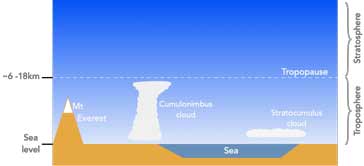Tropospheric Radio Propagation Explained
Understand how radio signals travel through the troposphere and are affected, especially as the effects become more noticeable at frequencies above about 30 MHz.
Home » Antennas & Propagation » this page
Tropospheric propagation includes:
Tropospheric propagation
Tropospheric enhanced conditions
Troposcatter communications
It is found that on frequencies above 30 MHz, the troposphere has an increasing effect on radio signals and radio communications systems.
Although propagation at these frequencies is often thought of as being line of sight, in fact they are able to travel over greater distances than would be expected.
Then at certain times and under specific conditions radio signals may be detected over distances of 500 or even 1000 km and more as a result of various enhancements, often called a "lift" in condition.
It is also possible to communicate relatively reliably using a scheme called troposcatter for which specialised troposcatter systems are used.
The way in which signals travel at frequencies of VHF and above is of great importance for those looking at radio coverage of systems such as broadcasting, mobile radio communications and other wireless systems as well as other users including radio amateurs.
What is the troposphere
The characteristics of the troposphere have a distinct affect on radio signals above about 30 MHz or so and this is why it is important to understand the basic makeup of this region of the atmosphere.
The troposphere is the lowest region of te Earth's atmosphere extending from sea or ground level up to an altitude of between about 6 and 18 km - its top is lower at the poles and higher in equatorial regionas.
The top of the troposphere is defined by the tropopause. Normally the temperature within the troposphere falls with increasing altitude, and the tropopause is where the the temperature ceases falling.
The troposphere contains about 75% of the total mass of the planetary atmosphere and about 99% of the total mass of water vapour, with the level of water vapour falling with altitude.It is also most weather phenomena occur.

It is also found that with increasing altitude, the density of the air diminishes, and it is for this reason that mountaineers climbing peaks like Mt Everest need oxygen, or even trekkers making their way to places like Machu Picchu have difficulty breathing.
Also the cabins in modern airliners are pressurised as they often fly at altitudes of 30 000 - 40 000 feet.
In terms of the factor that primarily affects radio communications, it is a variation in the refractive index of the air that affects radio communication. Both the reducing density of the air, and probably more so, the reducing level of water vapour have a small, but very significant affect.
Line of sight radio communications
It might be thought that most radio communications links at VHF and above follow a line of sight path. This would make the maximum distances achievable somewhere in the order of the distance of the horizon.
However this is not what is found in practice. Even under what might be termed normal conditions radio signals are able to travel or propagate over distances that are greater than the line of sight.
The reason for the increase in distance travelled by the radio signals is that they are refracted by small changes that exist in the Earth's atmosphere close to the ground.

It is found that the refractive index of the air close to the ground is very slightly higher than that higher up. As a result the radio signals are bent towards the area of higher refractive index, which is closer to the ground. It thereby extends the range of the radio signals.
The refractive index of the atmosphere varies according to a variety of factors. Temperature, atmospheric pressure and water vapour pressure all influence the value. Even small changes in these variables can make a significant difference because radio signals can be refracted over whole of the signal path and this may extend for many kilometres.
Tropospheric propagation effects occur comparatively close to the surface of the Earth. The radio signals are mainly affected by the region that is below an altitude of about 2 kilometres. As these regions are those that are greatly affected by the weather, there is a strong link between weather conditions and radio propagation conditions and coverage.
N units
In order to make the changes in refractive index of the air more meaningful and manageable, a system using N-units is widely used.
It is found that the average value for the refractive index of air at ground level is around 1.0003, but it can easily vary from 1.00027 to 1.00035.
In view of the very small changes that are seen, a system has been introduced that enables the small changes to be noted more easily. Units called "N" units are often used.
These N-units are obtained by subtracting 1 from the refractive index and multiply the remainder by a million. In this way numbers that are far more manageable and meaningful are obtained.
Where: μ is the refractive index.
It is found that as a very rough guide under normal conditions in a temperature zone, the refractive index of the air falls by about 0.0004 for every kilometre increase in height, i.e. 400 N units / km.
Figures like this cause the radio signals to tend to follow the Earth's curvature and travel beyond the geometric horizon. The actual values extend the radio horizon by about a third for most situations.
This factor is often used in most radio communications coverage calculations for applications such as broadcast radio transmitters, and other two way radio communications users such as two way mobile radio communications systems and the like.
Advantages & disadvantages of tropospheric propagation
Although there are some distinct advantages to the distance extensions that are provided by tropospheric radio propagation, it is necessary to understand, not only the advantages, but also the disadvantages that are associated with it.
Advantages associated with tropospheric propagation
Range: Tropospheric propagation can allow radio waves to travel over greater distances than they would if the troposphere were a uniform medium and this can have advantages for a number of radio services including broadcasting and radio amateurs amongst others.
Cost advantage: Tropospheric propagation can provide cost reductions in achieving a given coverage area. It can mean that antenna towers do not need to be as high to provide the same coverage or distances achieved and transmitter powers may ned to be less.
Disadvantages associated with tropospheric propagation
Unpredictable: Tropospheric propagation is not always reliable because, by its very nature it is affected by the atmospheric conditions in the troposphere, and these change from day to day as the weather changes. However for most days a reliable increase of about a third in range is reliably achievable. It is other effects that can come into play that can cause issues.
Affected by terrain: The amount and way in which signals are refracted can be affected by the terrain. For example in mountainous regions, refraction may not always occur in the manner that is beneficial.
By balancing the advantages and disadvantages of tropospheric radio propagation that the most can be made of the radio propagation in this portion of the radio spectrum.
Enhanced conditions: lifts, ducting & tropo
It has already been mentioned that tropospheric propagation is subject to changes in the prevailing conditions in the troposphere, i.e. the weather.
It is found that under some conditions, considerable enhancements in the distances over which signals can be heard are experienced, and terms like "lifts" and "ducting" may be heard when referring to them. Sometimes it may even jsut be called "tropo."
Often signals from a broadcast transmitter on a high hill top, for example, may be heard over distances up to 100 kilometers and more, but under some conditions their signals may be heard over distances of a few hundred kilometres, or even up to around 2000 kilometres.
Radio amateurs are keen to exploit these conditions and it is sometimes possible for them to establish contacts over distances ranging between a few hundred and even occasionally up to 2000km.
In terms of radio broadcasting, this can lead to increased levels of interference as signals are heard well beyond their intended coverage area, but for radio amateurs, it can bring the opportunity of long distance contacts.
Troposcatter for data links
There are always anomalies in the various areas of the troposphere - areas of higher or lower temperature, higher water vapour density and the like.
These may be a bit like large bubbles or other shaped regions and they have slightly different levels of refractive index. This naturally affects the radio signal propagation.
It is found that it is possible to direct a transmitted beam into the ionosphere, and a small amount of power will be scattered from these regions.
Although the power refracted back is small, these regions are always present and it gives the possibility of setting up a radio communications link to make use of this.
Relatively high powers and reasonably directive antennas are needed, but it can be a good way of providing a data link over distance up to, say, 800 or even possibly 1000km.
Troposcatter links are often used for remote data monitoring stations and avoid the reliance on satellites or unreliable HF communications.
Any terrestrial signals received at VHF and above will be subject to the prevailing propagation conditions caused by the troposphere. Under normal conditions it should be expected that signals will be able to be received beyond the normal line of sight distance. However under some circumstances these distances will be considerably increased and significant levels of interference may be experienced.
 Written by Ian Poole .
Written by Ian Poole .
Experienced electronics engineer and author.
More Antenna & Propagation Topics:
EM waves
Radio propagation
Ionospheric propagation
Ground wave
Meteor scatter
Tropospheric propagation
Antenna basics
Cubical quad
Dipole
Discone
Ferrite rod
Log periodic antenna
Parabolic reflector antenna
Phased array antennas
Vertical antennas
Yagi
Antenna grounding
Installation guidelines
TV antennas
Coax cable
Waveguide
VSWR
Antenna baluns
MIMO
Return to Antennas & Propagation menu . . .



